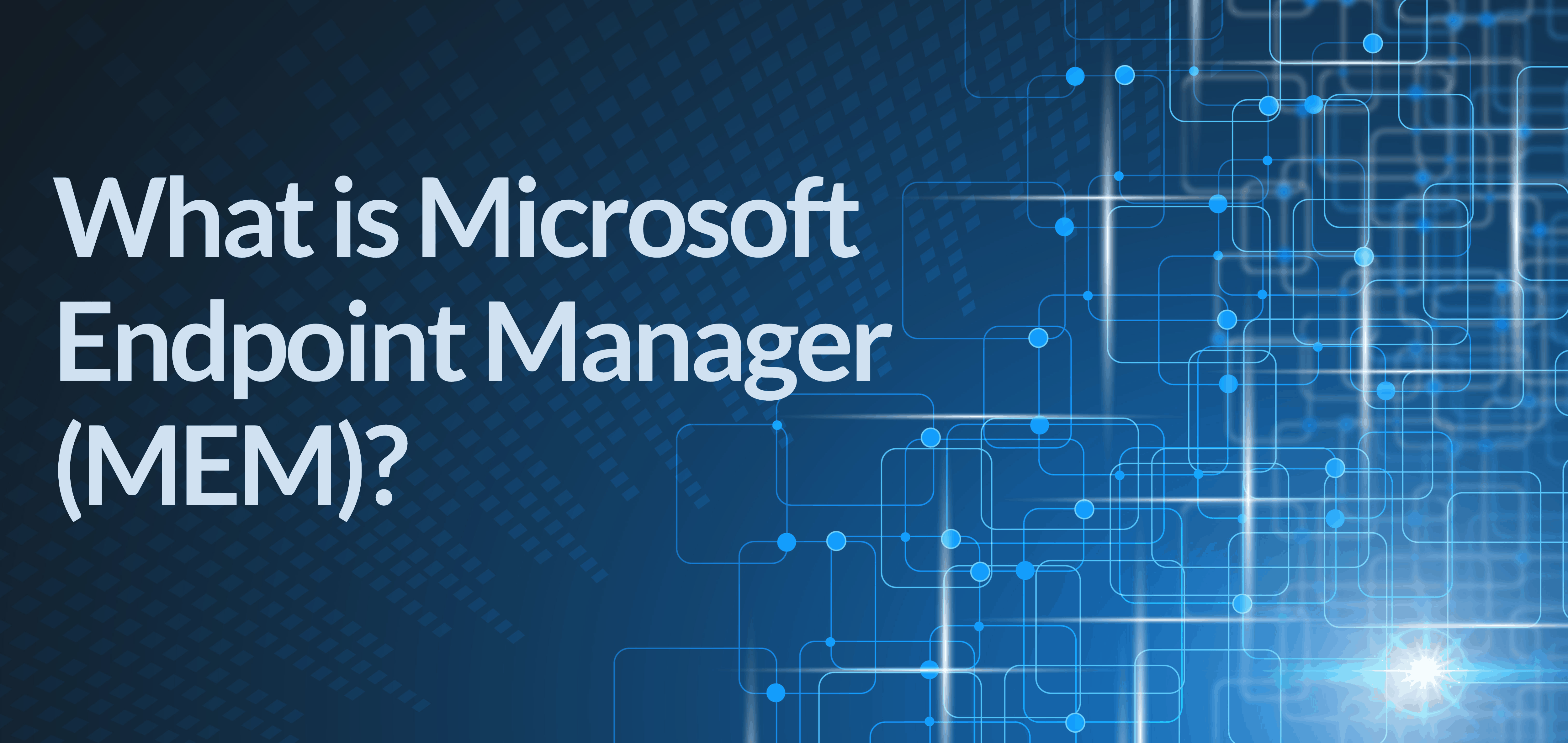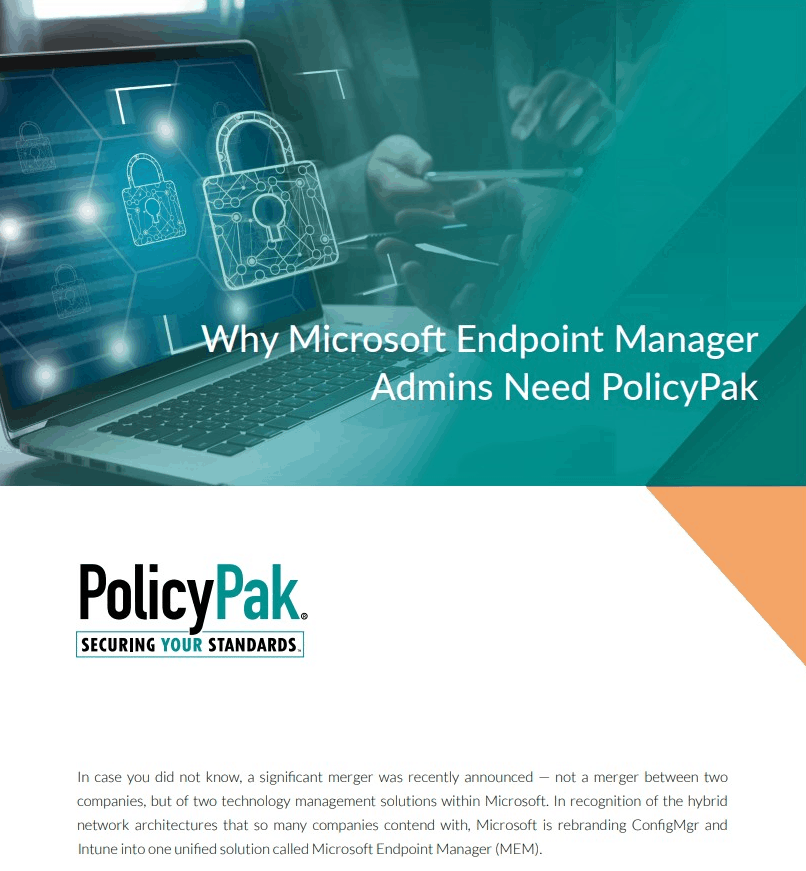Jeremy Moskowitz founded PolicyPak Software after working with hundreds of customers with the same problem they couldn’t manage their applications, browsers and operating systems using the technology they already utilized.

What is Microsoft Endpoint Manager (MEM)?
It is a wonderful thing when new initiatives benefit both the company behind the implementation and the customers it serves. Such is the case with the announcement at Ignite 2019 that ConfigMgr and Intune are being merged together to form a single management conglomerate tool called Microsoft Endpoint Manager (MEM). The Microsoft Endpoint Manager console will show a single view of all devices managed by either product through a single interface. Whether your ConfigMgr devices are currently co-managed or not, you can manage ConfigMgr through the Microsoft Endpoint Manager interface. Of course, you can still manage through one or the other if you wish, and there are some features that cannot be replicated between the two. Separately, the two tools will be known as the following:
- Microsoft Endpoint Manager Microsoft Intune (MEMMI)
- Microsoft Endpoint Manager Configuration Manager (MEMCM)
Branding and Licensing Simplification
Some may say that the merger is a recognition by Microsoft that the vast majority of companies will continue using ConfigMgr and group policies to manage enterprise desktop devices. While Intune is capable of managing your entire Windows 10 environment, many companies continue to limit its management scope to mobile devices.
For Microsoft, bringing the two management systems under one roof allows them to simplify their branding under one incorporated name. By integrating ConfigMgr into the Intune Portal itself, Microsoft is undoubtedly hoping that enterprises can better amalgamate themselves with the capabilities and functionality of Microsoft Endpoint Manager Microsoft Intune (MEMMI).
Users will enjoy the simplification of licensing and experience. Those enterprises that currently have ConfigMgr licenses will automatically have Intune licenses, too, allowing them to co-manage their desktop devices with both tools. From a product perspective, admins will be able to view their mobile devices and ConfigMgr controlled PCs from a single interface. No more having to bounce repeatedly back and forth between interfaces throughout the day.
Brad Anderson, Corporate Vice President at Microsoft, says, “It’s all about simplifying — and we’re taking that simplifying deep and broad from a branding, licensing and product perspective.”
By implementing the new co-existing licensing model, Microsoft is encouraging those companies that need to leave existing systems in place to provision new machines as cloud-managed devices. Regardless of how the is device managed, however, Microsoft Endpoint Manager (MEM) provides a single view of all devices managed by either product.
Examining the Licensing Structure
When you think of the new licensing model, think of the management scope of ConfigMgr. ConfigMgr specializes in PC desktop management, so your PC devices are now automatically licensed for Intune as well, so you can enable co-management if you want. Phones and non-Microsoft devices are still the exclusive domain of Microsoft Endpoint Manager Microsoft Intune (MEMMI), so those devices cannot receive dual licensing. Note you will still need Azure Active Directory P1 licensing for your users. Mobile devices, iOS, and Linux machines will remain exclusively licensed under Microsoft Endpoint Manager Microsoft Intune (MEMMI).
Why Microsoft Endpoint Manager Admins Need PolicyPak
Microsoft Endpoint Manager (MEM) unifies Microsoft ConfigMgr and Microsoft Intune in a way that provides greater efficiency, security and visibility for your modern enterprise. The benefits of this new co-managed solution go far beyond branding and licensing simplification. Microsoft will unveil a stream of new tools through MEM including a CSE tool, an add-on to MEMMI, and others. However, If you are accustomed to having access to the more than 10,000 real Group Policy and Group Policy Preference settings available in Windows Server AD environments, then Intune (or any MDM) will end up being a disappointment.
Intelligence-Driven
Modern management systems must be intelligence-based to maximize the user experience. There are currently 190 million devices managed by either ConfigMgr or Intune. The convergence of ConfigMgr and Intune greatly scales the potential use of telemetry power that Internal IT can utilize in its PC deployments and problem-solving. MEM will be introducing an array of intelligent actions that will give admins granular analysis and new comparative insights to their environments versus others.
One example of this is the Productivity Score. Productivity Score will allow organizations to evaluate their employee and technology experiences into measurable metrics that Internal IT can use to justify the value it brings to the organization. From the perspective of the user experience, it will quantify how people are collaborating on content, developing a meeting culture and communicating. Real measured results concerning these types of user experiences can offer insights into how to enhance the user experience and increase productivity. The technology experience will provide insights into assessing policies, device settings and boot times, application performance and adherence to security compliances.
MEM is an Endpoint
Many of us predicted this would happen someday. As companies strive to transform their organizations digitally from the ground up, it was only a matter of time until something was done to streamline the management of on-premise and mobile desktops in scale. One point Anderson emphasized in his Intune presentation MEM is that the merging of these two management system giants is not a temporary arrangement. Anderson says,
“Let me be very clear — this vision includes both ConfigMgr and Intune. Co-management isn’t a bridge; it’s a destination.”
MEM allows you to start utilizing cloud intelligence without making a single change to your ConfigMgr policies. Working collaboratively, yet remaining visible and accessible through a single interface, MEM provides the modern management system that Windows enterprises need. End-to-end management and automation are now available in a converged license package. Look for the MEM transformation to emerge within your Intune environment.
Additional Management and Security for MEM
PolicyPak is ready today to enhance your Microsoft Endpoint Manager (MEM) investment. PolicyPak Group Policy Edition is also known as our On-Prem edition and works alongside Group Policy or SCCM. PolicyPak MDM Edition is licensed alongside (or without) the PolicyPak Group Policy Edition and can enhance your Intune environment.
SIGN UP FOR A POLICYPAK WEBINAR »
To see where PolicyPak fits into the MEM strategy, take a look at the video below.



